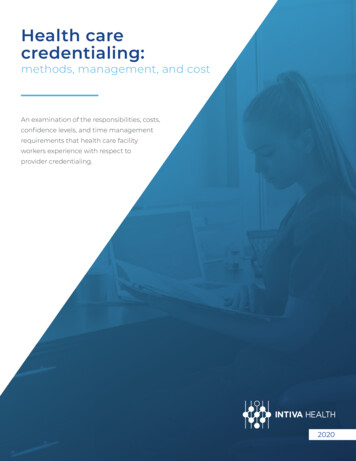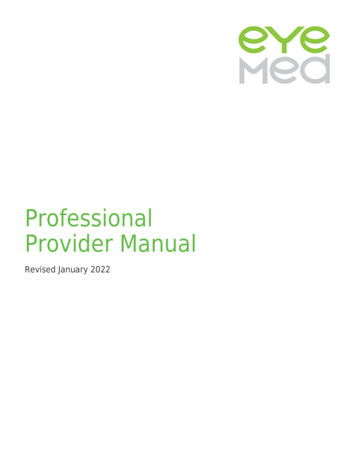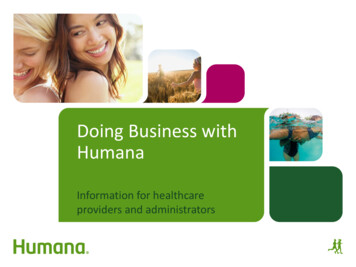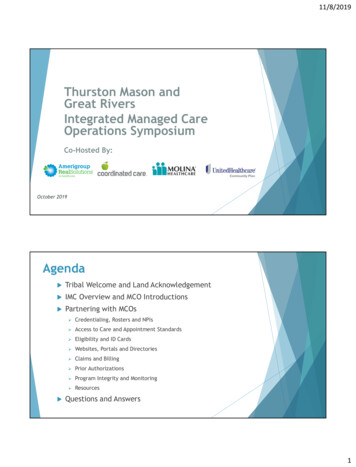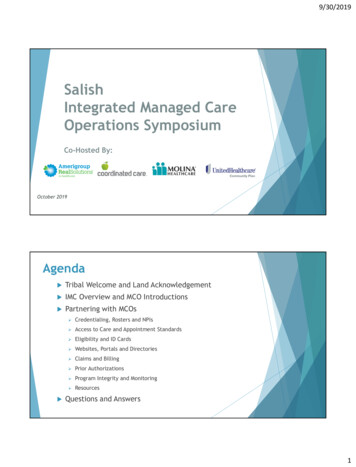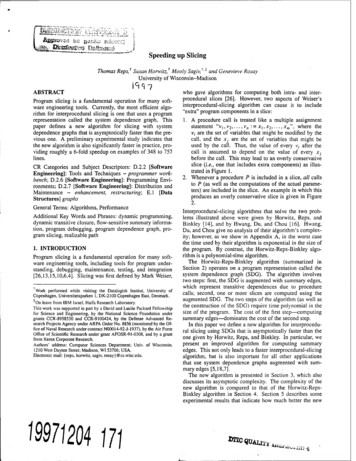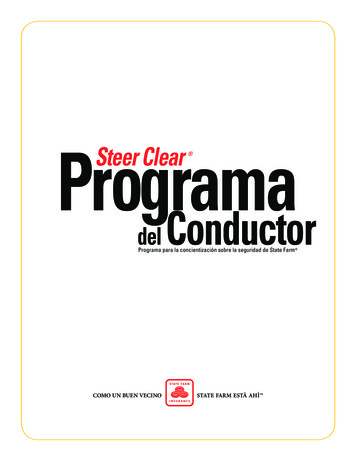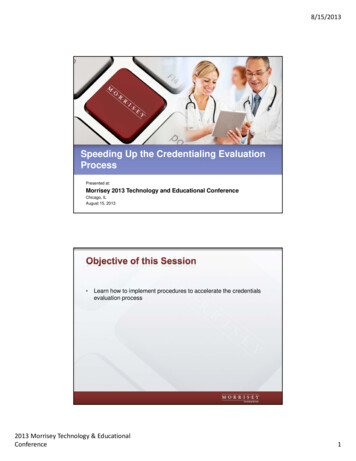
Transcription
8/15/2013Speeding Up the Credentialing EvaluationProcessPresented at:Morrisey 2013 Technology and Educational ConferenceChicago, ILAugust 15, 2013 Learn how to implement procedures to accelerate the credentialsevaluation process2013 Morrisey Technology & EducationalConference1
8/15/2013 Fear that change may impact the integrity of the current process Fear that change may have an adverse impact on compliance withaccreditation requirements Unwillingness to change – more comfortable maintaining “statusquo”» Medical Staff Office» Medical Staff Organization Lack of time to implement new processes Poor use of technology (i.e., credentialing software) No data about how much time the current evaluation process takes Avoid appointing practitioners that have “problems” such asbehavior issues, etc., that will be difficult to deal with later Protect patients by ensuring that practitioners are currentlycompetent to exercise the privileges granted Protect the assets and reputation of the organization Documentation that supports the credentialing and privilegingdecisions made Meet accreditation and licensing requirements2013 Morrisey Technology & EducationalConference2
8/15/2013 Support from a high-functioning Medical Staff Office/CredentialingDepartment Department Chairs that understand and carry out their roles andresponsibilities A high-functioning Credentials Committee Criteria-based credentialing and privileging Policies and procedures that address all components of thecredentialing and privileging process – for example» Waiver of criteria» Adding new procedures; using new technology Educated governing body that understands its responsibility formaking credentialing and privileging decisions – and holds themedical staff accountable for their role in credentialing andprivileging2013 Morrisey Technology & EducationalConference3
8/15/2013 Technology available to help expedite the evaluation and decisionmaking process Willingness on the part of medical staff leadership (and the supportindividuals from the medical staff office/credentialing department) toconsider new processes – for example:» Review of files in advance of Credentials Committee meetings (insteadof at the meeting)» Credentials Committee meetings where the files are presentedelectronically» Credentials Committee only deals with problem files at meeting – thosethat are not problems are dealt with outside of meetings Performing quality control» All required information verified in accordance withpolicies/procedures?» Follow-up completed?» Evidence that privileging criteria met?» File summary prepared?» File identified for accelerated credentialing?» Red flags identified? Notification to department chair that file is ready forreview» Can you track the amount of time that it takes chairs toreview assigned files?2013 Morrisey Technology & EducationalConference4
8/15/2013 If yes, by whom?Department ChairCredentials Committee?Is there more than one interview?Is it an “in person” interview or can it be handled via the telephone orteleconference? Who makes arrangements for the interview? Is there specific information that is gathered during the interview? Is what was learned during the interview documented?2013 Morrisey Technology & EducationalConference5
8/15/2013 Preparation of a recommendation form in order to capture excellentdocumentation Orientation of department chairs related to their responsibility forreview of files and making privileging recommendations Incorporating the six general competencies into the evaluation anddecision-making process2013 Morrisey Technology & EducationalConference6
8/15/2013 Committee description that identifies specific dutiesClear roles and responsibilities of the committee and membersExperienced ChairWritten qualifications and job descriptionEvaluation processCommitted membersWritten qualifications members of the committeeCredentialing experienceInterestedEducatedIneffective members don’t get reappointed to the committeeLong termsOrganization shouldn’t be under the misunderstanding that thecredentials committee must be representative of allspecialties/departments Meetings should be balanced between making credentialingrecommendations and making recommendations on policy issues Does the committee have primary oversight of privileging(development of forms, criteria, privileging disputes)? Provide sufficient time/mechanisms for this oversight2013 Morrisey Technology & EducationalConference7
8/15/2013The only way to find the time for work that doesn’t relatespecifically to credentialing and privilegingrecommendations is to Have extra meetings (not a very appealing option) Structure committee activities so that only issues that warrantdiscussion are addressed by the full committee Consider “accelerated credentialing” policy/procedure to focusattention on problem files Perform routine work outside of committee meetings Credentials Committee meeting time should not be spent “auditing”files to check for presence of routine information If at the start of each Credentials Committee meeting, each memberhas a stack of files to review, there is a problem with how thecommittee is organized to do its work2013 Morrisey Technology & EducationalConference8
8/15/2013Paperless Credentials Committee meetings are a reality forsome organizations – is your organization ready for thisstep? If not – WHY NOT? Methods» Providing access to agendas, and other materials that need to bereviewed prior to meeting time on secure website» Use of LCD at meeting to focus committee attention on relevant issues Committee should be the organization’s experts related tocredentialing and privileging Education provided for committee members Conferences Access to newsletters and publications Audioconferences Time for discussion at meetings Committee keeps current on new developments Develops new policies and procedures (and revises old ones)proactively2013 Morrisey Technology & EducationalConference9
8/15/2013 The role of Medical Staff Support Services cannot beoveremphasized Coordination and implementation of processes Preparation of files for review Red-flagging of pertinent issues Researching privileging criteria, policies and procedures, newcredentialing and privileging developments Resource at committee meetings The committee doesn’t conduct meaningless interviews The committee is proactive and stays current on requirements,regulations, etc. Good decisions are made The committee routinely analyzes its effectiveness The committee is able to demonstrate its effectiveness to the MECand Board through regular reporting Meetings don’t get bogged down in minutia The committee stays focused on competency The committee is not overwhelmed with paper2013 Morrisey Technology & EducationalConference10
8/15/2013 If you want to know the status of a file, someone has to find the file If you are a Department Chair or Credentials Committee member » There is so much paper that you just go to wherever there is a red flagor a sticky note» You don’t know what is on a physician profile, why it got on the profile,what it means or how you are supposed to react to it» You must sign your name (and date it) multiple places in each file The Credentials Committee agenda isn’t completed untilhours/minutes prior to the meeting Applicants show up for Credentials Committee meetings to beinterviewed and no one on the committee can ask them anythingspecific or relevant because their file hasn’t been reviewed yet» “ tell us about your background .” Credentials Committee meetings are entirely devoted to file review The process has a physician-protective focus rather than a patientprotective focus2013 Morrisey Technology & EducationalConference11
8/15/2013 The medical staffoffice or credentialingdepartment looks likethis pictureCredentials FilesLook Like This!2013 Morrisey Technology & EducationalConference12
8/15/2013Q&A2013 Morrisey Technology & EducationalConference13
2013 Morrisey Technology & Educational Conference 1 Speeding Up the Credentialing Evaluation Process Presented at: Morrisey 2013 Technology and Educational Conference Chicago, IL August 15, 2013 . Poor use of technology (i.e., credentialing software) No data about how much time the current evaluation process takes


